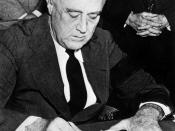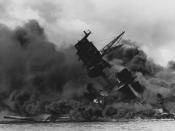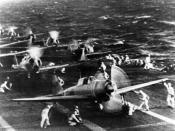The Japanese attack on Pearl Harbor could be considered one of the worst surprise attacks in
American history. For every Japanese crewman or pilot killed, almost thirty-eight Americans were killed.
Before the attack, the American government had tried to negotiate many times with Japan's
leaders to withdraw their troops from China and put an end to the war. Japan had already seized many
bases in northern Vietnam and occupied the south in July of 1941, threatening a route to China and the
British control of Malaya and Burma. President Franklin D. Roosevelt then froze all Japanese assets and
put an embargo on all of their trade in oil, chemicals, steel, machinery and other goods, which dealt Japan a
devastating blow, because Japan bought more than fifty percent of its imports from the United States. The
British and Dutch later put similar embargoes on Japan's goods. Later that spring, Roosevelt moved the
Pacific Fleet's headquarters from San Diego to Pearl Harbor.
In late 1941, the Nave Department sent a message to its commanders, specifically Admiral
Husband Kimmel, the Pacific Fleet chief in Pearl Harbor: "This dispatch is to be considered a war warning.
Negotiations with Japan have ceased and an aggressive move by Japan is expected within the next few
days." Sixty-year-old Kimmel took the warning as "no more than saying that Japan was going to attack
someplace."
Many people in Washington thought that the Japanese would attack the Philippines, so General
Douglas MacArthur, retired Chief of Staff, overconfidently said that he would have 200,000 Filipinos ready
for combat soon.
On November 26, 1941, Chuichi Nagumo's armada left Hitokappu Bay, bound for Pearl Harbor.
There were six carriers, 400 warplanes, two battleships, two cruisers, nine destroyers and a dozen other
ships. Its orders were that if there was an agreement made...



Overal Good
This essay is an overal good essay, it give details to the event, but its not the greatest essay on peral harbor because there are some minor errors in the context, and general history of the attack is left out
2 out of 2 people found this comment useful.